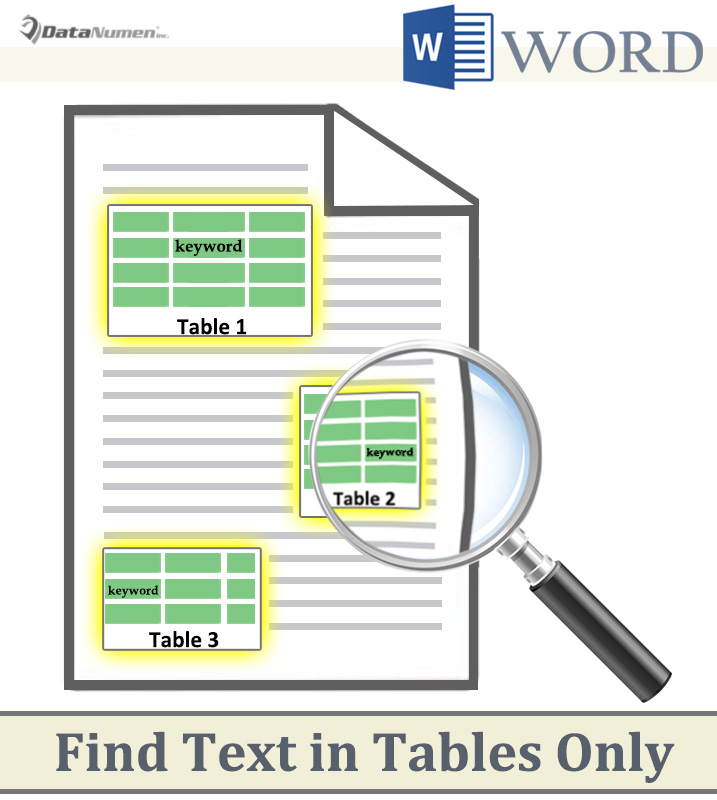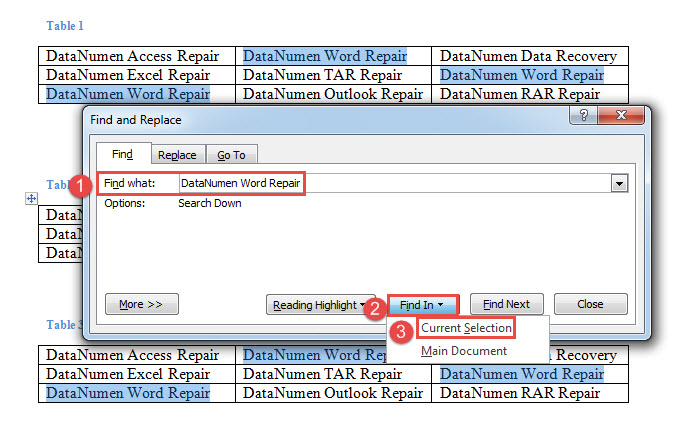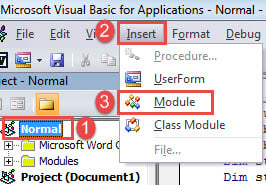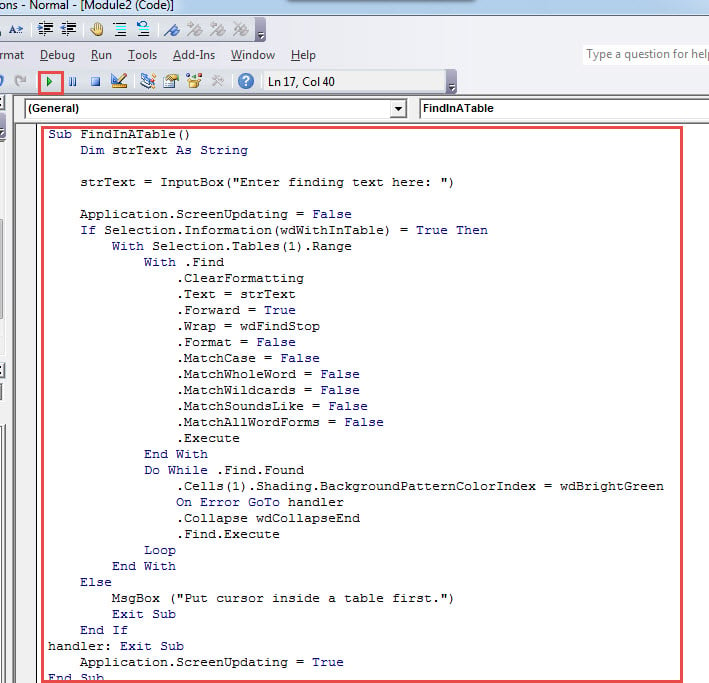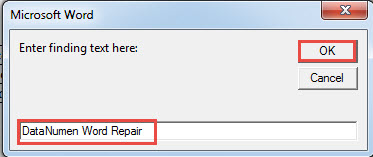In this article, we are glad to show you 3 quick ways to find specific text in your Word tables only.
Utilizing the “Find and Replace”, a built-in function in Word, you can search for and find a specific text in a long document. As you see, this is based on the entire document. How about we limit the searching range to Word tables only? Read on to see details.
Method 1: Find Text in Selection
- First of all, manually select one or more tables in document.
- Then click drop-down button next to “Find” command under “Home” tab.
- Choose “Advanced Find” to open “Find and Replace” dialog box.
- Enter finding text in “Find what” text box.
- Click “Find In” tab and choose “Current Selection”.
Word will find text in your selection only.
Method 2: Find Text in a Table
Besides the usual way, you can choose to run macro to do more customized tasks.
- First off, put cursor inside a table where you want to find text.
- Then press “Alt+ F11” to open VBA editor.
- Click “Normal” on the left column.
- Then click “Insert” and choose “Module”.
- Next double click the module to open it.
- Paste following codes into module:
Sub FindInATable()
Dim strText As String
strText = InputBox("Enter finding text here: ")
Application.ScreenUpdating = False
If Selection.Information(wdWithInTable) = True Then
With Selection.Tables(1).Range
With .Find
.ClearFormatting
.Text = strText
.Forward = True
.Wrap = wdFindStop
.Format = False
.MatchCase = False
.MatchWholeWord = False
.MatchWildcards = False
.MatchSoundsLike = False
.MatchAllWordForms = False
.Execute
End With
Do While .Find.Found
.Cells(1).Shading.BackgroundPatternColorIndex = wdBrightGreen
On Error GoTo handler
.Collapse wdCollapseEnd
.Find.Execute
Loop
End With
Else
MsgBox ("Put cursor inside a table first.")
Exit Sub
End If
handler: Exit Sub
Application.ScreenUpdating = True
End Sub
- Lastly, click “Run”. Enter a text inside the input box and click “OK” to proceed.
Method 3: Find Text in All Tables in a Document
- First and foremost, repeat steps in method 2 to install and run a macro.
- Next replace that macro with this one:
Sub FindTextsInAllTables()
Dim strText As String
strText = InputBox("Enter finding text here: ")
Application.ScreenUpdating = False
With Selection
.HomeKey Unit:=wdStory
With Selection.Find
.ClearFormatting
.Text = strText
.Forward = True
.Wrap = wdFindStop
.Format = False
.MatchCase = False
.MatchWholeWord = False
.MatchWildcards = False
.MatchSoundsLike = False
.MatchAllWordForms = False
.Execute
End With
Do While .Find.Found = True
If .Information(wdWithInTable) = True Then
.Cells(1).Shading.BackgroundPatternColorIndex = wdBrightGreen
End If
.Collapse wdCollapseEnd
.Find.Execute
Loop
End With
Application.ScreenUpdating = True
End Sub
- Similarly, type searching text inside the input box. And click “OK” to proceed.
Rescue Your Data in Time
Once you get compromised data, keep in mind that they are recoverable. So never give up before trying. Under such circumstances, you need to check your latest backup, if any. There is a good chance to have some of your data back. Besides, you can always resort to doc fix tool to recover data.
Author Introduction:
Vera Chen is a data recovery expert in DataNumen, Inc., which is the world leader in data recovery technologies, including damaged xls and pdf repair software products. For more information visit www.datanumen.com
12 / 11 / 3
Регистрация: 07.09.2015
Сообщений: 256
21.04.2020, 13:45
7
Narimanych,
Сообщение от Narimanych
Кикие следующие действия после нахождения?
Да там, задача простая. В определённой таблице (именно в таблице №7) найти текст в строке, (например: «Отчёт №3», а их например всего пять),
и удалить все строки
(со столбцами)
идущие до этого текста
(в таблице).
Т.е. скажем так: укоротить таблицу, обрезая её с начала. А флагом остановки, служит искомый текст. Это, то я реализую. Хотя если будет, хороший пример (как выше), буду благодарен.
Сообщение от Narimanych
| Visual Basic | ||
|
Блин, спасибо! Красивая реализация!
Вот совсем запамятовал про Метод «Like» 
И с
| Visual Basic | ||
|
тоже круто
Не по теме:
Думаю: Т.к. мне искать только в одной таблице, всё ок.
А вот если перебирать каждую ячейку, например в 10 таблицах, то конечно, возможно, метод «Like» не так быстро справится как метод «Find». (не стану писать, что подвиснет, но … есть немного похожий код с выравниванием, вот там тоже все ячейки перебираются, ворд, как-то с этим грустно, справляется).
Добавлено через 24 минуты
Narimanych,
Сообщение от Narimanych
Кикие следующие действия после нахождения?
На самом деле, ещё один нюанс. Надо будет, потом, после строки (заголовка — «Отчёт №6», она без столбцов) найти максимальное число в последних 4 столбцах (всего столбцов 8).
Хотя опять же, уверен с этим справлюсь.
Не по теме:
Сообщение от Schumacher57
А вот если перебирать каждую ячейку, например в 10 таблицах, то конечно, возможно, метод «Like» не так быстро справится как метод «Find»
Зря. Всё чётко, и быстро отработал. Проверил, сейчас.
0
- Remove From My Forums
-
Question
-
Hellow,
What I want to do: I need to find the text Orange, Grapes & Guava in column 2 and update the text in corresponding cell in column 3 for the same row as “Like”.
Col 2
Col 3
Apple
Like
Orange
Dislike
Grapes
Dislike
Blue Berry
Dislike
Black Berry
Like
Guava
Dislike
Mange
Dislike
regards
SCOMDev
SCOMDev
Answers
-
Cross-posted at:
http://answers.microsoft.com/en-us/office/forum/office_2010-word/how-to-find-and-replace-text-inside-a-table-cells/138626ca-b101-4e0e-9715-55971eb12822
and
https://social.msdn.microsoft.com/Forums/office/en-US/7e10b4f7-c611-4f3f-9c1c-4f83aac563e7/extracting-tables-and-images-from-word-document?forum=worddevFor cross-posting etiquette, please read:
http://www.excelguru.ca/content.php?184Try:
Sub Demo()
Application.ScreenUpdating = False
Dim StrFnd As String, i As Long, Rng As Range
StrFnd = «Apple,Black Berry»
With ActiveDocument.Tables(1)
Set Rng = .Range
For i = 0 To UBound(Split(StrFnd, «,»))
With .Range
With .Find
.ClearFormatting
.Replacement.ClearFormatting
.Text = Split(StrFnd, «,»)(i)
.Replacement.Text = «»
.Forward = True
.Wrap = wdFindStop
.Format = False
.MatchWildcards = True
.Execute
End With
Do While .Find.Found
If .InRange(Rng) Then
If .Cells(1).ColumnIndex = 2 Then
.Cells(1).Next.Range.Text = «Like»
End If
Else
Exit Do
End If
.Collapse wdCollapseEnd
.Find.Execute
Loop
End With
Next
End With
Application.ScreenUpdating = True
End SubNote: as coded, the macro assumes you want to process the first table in the document. If you want to work with a different table, change the (1) in ‘ActiveDocument.Tables(1)’ to refer to that table. If you want to work with a selected table,
change ‘ActiveDocument’ to ‘Selection’.
Cheers
Paul Edstein
[MS MVP — Word]-
Edited by
Monday, October 27, 2014 9:32 PM
Updated code -
Proposed as answer by
Fei XueMicrosoft employee
Tuesday, October 28, 2014 6:08 AM -
Marked as answer by
Fei XueMicrosoft employee
Wednesday, November 5, 2014 12:22 PM
-
Edited by
Hello — I have a tool to find and replace text within Word documents in a specified folder that I’ve cobbled together, which works pretty well. However, I need to be able to find text within a table in the specified document(s) and then replace text that is three cells to the right of that found text. Alternately, I need to be able to find specific text in the table, then find other specific text in the same row and replace that. Hope that makes sense. Table would look something like this:
Dog | Food | Dish | Water
Cat | Food | Bowl | Milk
Bird | Seed | Bottle | Water
I would want to find the row with «Bird» and then replace «Water» with «Juice». I don’t want to replace the first instance of «Water» (in the «Dog» row); only in the row starting with «Bird.»
Any ideas? My code is below:
Sub FindReplace()
Dim rngStory As Word.Range
Dim pFindTxt As String
Dim pReplaceTxt As String
Dim lngJunk As Long
Dim oShp As Shape
pFindTxt = InputBox(«Enter the text that you want to find.» _
, «FIND»)
If pFindTxt = «» Then
MsgBox «Cancelled by User»
Exit Sub
End If
TryAgain:p
ReplaceTxt = InputBox(«Enter the replacement.», «REPLACE»)
If pReplaceTxt = «» Then
If MsgBox(«Do you just want to delete the found text?», _
vbYesNoCancel) = vbNo Then
GoTo TryAgain
ElseIf vbCancel Then
MsgBox «Cancelled by User.»
Exit Sub
End If
End If
Dim FolderName As String
With Application.FileDialog(msoFileDialogFolderPicker)
.AllowMultiSelect = False
.Show
On Error Resume Next
FolderName = .SelectedItems(1)
Err.Clear
On Error GoTo 0
End With
Dim fso, newFile, folder, files
Set fso = CreateObject(«Scripting.FileSystemObject»)
Set folder = fso.GetFolder(FolderName)
Set files = folder.files
For Each file In files
Documents.Open FileName:=file.Path
Application.DisplayAlerts = False
‘Fix the skipped blank Header/Footer problem
lngJunk = ActiveDocument.Sections(1).Headers(1).Range.StoryType
‘Iterate through all story types in the current document
For Each rngStory In ActiveDocument.StoryRanges
‘Iterate through all linked stories
Do
SearchAndReplaceInStory rngStory, pFindTxt, pReplaceTxt
On Error Resume Next
Select Case rngStory.StoryType
Case 6, 7, 8, 9, 10, 11
If rngStory.ShapeRange.Count > 0 Then
For Each oShp In rngStory.ShapeRange
If oShp.TextFrame.HasText Then
SearchAndReplaceInStory oShp.TextFrame.TextRange, _
pFindTxt, pReplaceTxt
End If
Next
End If
Case Else
‘Do Nothing
End Select
On Error GoTo 0
‘Get next linked story (if any)
Set rngStory = rngStory.NextStoryRange
Loop Until rngStory Is Nothing
Next
ActiveDocument.Save ActiveDocument.Close
Next
Application.DisplayAlerts = True
MsgBox «Done!»
End Sub
Sub SearchAndReplaceInStory(ByVal rngStory As Word.Range, _
ByVal strSearch As String, ByVal strReplace As String)
With rngStory.Find
.ClearFormatting
.Replacement.ClearFormatting
.Text = strSearch
.Replacement.Text = strReplace
.Wrap = wdFindStop ‘Continue
.Execute Replace:=wdReplaceOne ‘All
End With
End Sub
Written by Allen Wyatt (last updated July 18, 2022)
This tip applies to Word 2007, 2010, 2013, 2016, 2019, and Word in Microsoft 365
When Peter wants to find a word at the end of a paragraph, he searches for XXX^p and replaces it with YYY^p. This doesn’t, however, find words at the very end of table cells. He wonders how he can search and replace the words at the end of table cells and if there is a special code similar to ^p.
There is no special code similar to ^p (end of paragraph) to indicate the end of a cell. There is a trick you can try, however, that works well for many people.
First, create a unique paragraph style that you will use only for the contents of the cells in your table. Make sure you apply this style to all of the cells within the table. Next, use Find and Replace to search for the style. In the Replace With box, enter the code ^& followed by what you want to add to the end of the cell. Then, step through all occurrences and do your replacements, as desired. The ^& code specifies that you want to replace what you found (the text in the cells formatted with the unique style) with what you actually found.
If you want to replace a specific word in the table cells (XXX) with something new (YYY), you can follow the same steps as above, simply search for any occurrences of XXX using the unique table-cell style and replace it with YYY. You’ll still want to step through the matches and determine if the replacement should be made on a case-by-case basis, but you will be able to make the changes in your table much quicker.
WordTips is your source for cost-effective Microsoft Word training.
(Microsoft Word is the most popular word processing software in the world.)
This tip (13571) applies to Microsoft Word 2007, 2010, 2013, 2016, 2019, and Word in Microsoft 365.
Author Bio
With more than 50 non-fiction books and numerous magazine articles to his credit, Allen Wyatt is an internationally recognized author. He is president of Sharon Parq Associates, a computer and publishing services company. Learn more about Allen…
MORE FROM ALLEN
Shortcut for AutoCorrect Dialog Box
There is no built-in keyboard shortcut that will display the AutoCorrect dialog box. This doesn’t mean that there aren’t …
Discover More
Grabbing the MRU List
Want to use the list of most recently used files in a macro? You can access it easily by using the technique presented in …
Discover More
Creating a Log/Log Chart
If you need to create a chart that uses logarithmic values on both axes, it can be confusing how to get what you want. …
Discover More
More WordTips (ribbon)
Nudging a Table
When laying out a page, you often need to move objects around to get them into just the right position. Word allows you …
Discover More
Formatting an ASCII Table with Tabs
If you get a document from a coworker that has tabs used to line up tabular information, you might want to change that …
Discover More
Table Rows Truncated in Printout
If you have problems getting the printout of a table to look correct, it can be frustrating. This tip provides a few …
Discover More

